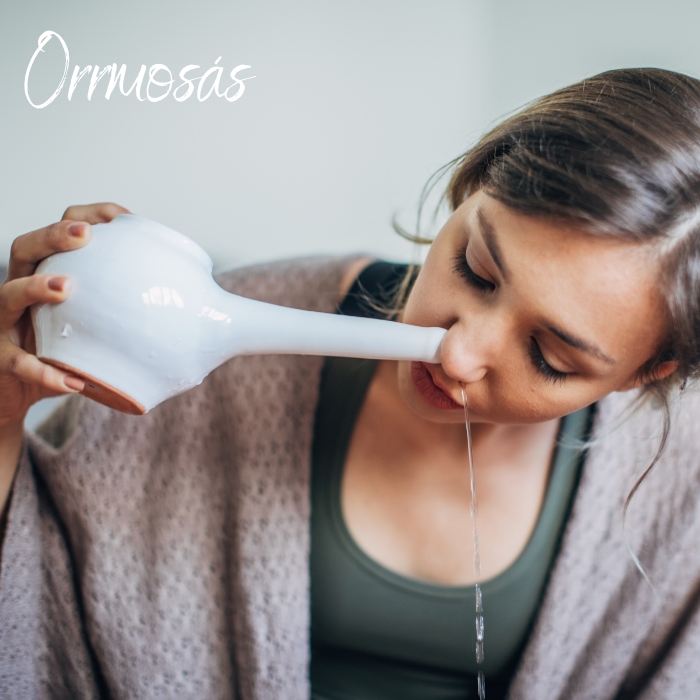
Nasal Irrigation Against Upper Respiratory Infections: The Neti Pot
The ancient Indian Ayurvedic tradition offers numerous techniques and tools to maintain physical and mental balance. Among the six yogic cleansing practices (shat kriyas), the jala neti—the use of a neti pot for nasal irrigation—stands out as an effective method for cleansing the nasal passages. This technique is simple enough for children to learn and safe for adults to use with proper guidance and practice. Today, the neti pot is globally recognized as a straightforward yet powerful tool to support respiratory health, especially for individuals living in polluted urban environments, those suffering from allergies, or anyone prone to upper respiratory issues.
Learn more about the benefits and usage of the neti pot and give your sinuses and airways a natural, effective boost!
What Is a Neti Pot?
A neti pot is a small container designed for flushing out the nasal passages and sinuses. It is made from various materials such as copper, ceramic, or sometimes plastic. While creative DIY versions exist, store-bought options are usually more convenient and reliable.
Although nasal irrigation is not yet a widespread practice in Europe, incorporating it into your daily routine offers both hygienic benefits and long-term support for overall well-being. The process takes only a few minutes but leaves you feeling remarkably refreshed.
The Benefits of Nasal Irrigation
Using a neti pot goes beyond merely cleaning the nasal passages. Its health effects extend to removing accumulated pollutants and mucus, offering multiple benefits:
- Cleaning and Protecting the Respiratory System
- Effectively removes dust, pollen, and other allergens from the nasal passages.
- Reduces mucus buildup in the sinuses, promoting easier breathing.
- Prevents sinus infections, frontal sinus inflammation, and other respiratory illnesses by clearing pathogens and mucus.
- Relieving Allergy and Asthma Symptoms
Regular use can reduce allergic reactions by washing away irritants from the nasal lining.
- Improving Sleep Quality
Open nasal passages promote restful sleep, especially for those who struggle with nighttime congestion.
- Supporting the Nervous System and Brain Function
Stimulating the nerve endings in the nasal cavity can improve oxygen supply to the brain, enhancing concentration and mental clarity.
- Benefiting Eye Health
By reducing sinus pressure, nasal irrigation may indirectly relieve eye strain and fatigue.
When Should You Use a Neti Pot?
Nasal irrigation is particularly beneficial in the following situations:
- Allergies (e.g., hay fever, dust allergy).
- Upper respiratory infections or prolonged colds.
- Frequent sneezing or nasal congestion.
- Preventing or treating sinus infections.
What to Use in the Neti Pot?
For nasal irrigation, use lukewarm or comfortably warm saline water. To prepare the solution:
- Dissolve 1 to 1.5 teaspoons of salt in a litre of water.
- This mildly saline solution is gentle on the mucous membranes and supports their recovery.
You can also enhance the solution with medicinal herbs like chamomile or thyme:
- Chamomile: Anti-inflammatory, soothing, and disinfecting properties.
- Thyme: Antibacterial, immune-boosting, and supports easier breathing—ideal for colds.
How to Perform Nasal Irrigation
Mastering the technique of using a neti pot is simple, though it may feel unusual at first.
Steps:
- Stand comfortably over a sink or bathtub, leaning slightly forward, and tilt your head to one side.
- Insert the spout of the pot into the upper nostril. Ensure the pot is angled correctly so water flows through the nasal passage and exits the lower nostril.
- Breathe through your mouth or hold your breath, keeping your mouth open during the process.
- Repeat the process on the other side.
- After irrigation, thoroughly dry the nasal passages. Lean slightly forward, close one nostril, and blow gently to remove residual water and mucus.
Common Questions and Tips for Beginners
What if it feels strange to pour water into my nose?
This is normal! The first few times may feel odd or uncomfortable, but with practice, the sensation becomes routine, and discomfort disappears.
Why is head positioning important?
Proper head tilt prevents water from entering the ears, avoiding discomfort.
How should I clean the neti pot?
Always rinse the neti pot thoroughly after each use to prevent bacteria buildup. For best results, choose one made from natural materials.
Can children use a neti pot?
Yes! With proper guidance, children can quickly learn how to use the neti pot. Introducing the process in a playful way can help overcome initial hesitation.
How to Teach Children Nasal Irrigation
- Set an Example: Demonstrate the steps and explain them clearly. Kids often feel more confident seeing their parents or siblings use it.
- Go Step-by-Step: Start by teaching how to tilt their head correctly, then practice breathing through the mouth.
- Make It Fun: Use playful phrases like, "Watch the water flow like a tiny river!" or, "Imagine the dust particles swimming away!"
- Be Patient: Allow time for children to get comfortable with the process.
Give Nasal Irrigation a Try!
Using a neti pot is a simple, safe, and highly effective way to maintain your daily health. Whether you’re battling allergies, dealing with frequent respiratory issues, or looking to prevent them, regular nasal irrigation can significantly improve your well-being—especially during the cold and flu season.
Embrace this Ayurvedic technique, breathe freely, and stay healthy!
